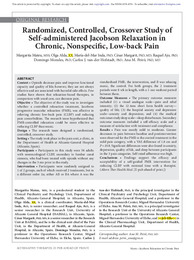Título :
Randomized, Controlled, Crossover Study of Self-administered Jacobson Relaxation in Chronic, Nonspecific, Low-back Pain |
Autor :
Mateu, Margarita
ALDA, OLGA 
Inda, María del Mar
Margarit, César
Ajo Ferrer, Raquel 
Morales, Domingo 
Van-der Hofstadt, Carlos
Peiró, Ana  |
Editor :
Aliso Viejo, CA : InnoVision Communications |
Departamento:
Departamentos de la UMH::Farmacología, Pediatría y Química Orgánica |
Fecha de publicación:
2018-11 |
URI :
https://hdl.handle.net/11000/32358 |
Resumen :
Context: Opioids decrease pain and improve functional capacity and quality of life; however, they are not always effective and are associated with harmful side effects. Few studies have shown that relaxation-based therapies, in comparison with usual care, can decrease pain.
Objective: The objective of the study was to investigate whether a controlled relaxation treatment, Jacobson progressive muscular relaxation (PMR), was effective in relieving chronic low-back pain (CLBP) and reducing pain comorbidities. The research team hypothesized that PMR-controlled relaxation could be more effective in reducing CLBP than music.
Design: The research team designed a randomized, controlled, crossover study.
Setting: The study took place in the pain unit, a clinic, in the Department of Health at Alicante-General Hospital (Alicante, Spain).
Participants: Participants in this study were 58 adults with nononcological CLBP, secondary to lumbar canal stenosis, who had been treated with opioids without any changes in the 3 mo prior to the study.
Intervention: Participants were randomly assigned to 1 of 2 groups, each of which received 2 treatments, but in a different order (ie, either AB or BA where A was the standardized PMR, the intervention, and B was relaxing music, the control. For both groups, the 2 treatment periods were 8 wk in length, with a 1-mo washout period between them.
Outcome measures: The primary outcome measures included (1) a visual analogue scale-pain and relief intensity; (2) the 12-item short form health survey-quality of life; (3) the hospital anxiety and depression scale-anxiety and depression; and (4) the medical outcomes study sleep scale-sleep disturbances. Secondary outcome measures included a self-efficacy scale and a measure of satisfaction with treatment and compliance.
Results: Pain was mostly mild to moderate. Greater decreases in pain between baseline and postintervention were observed for the PMR vs the control treatment in the mild pain category, with a VAS difference of 1.8 cm and P = .018. Significant differences were also found in anxiety, depression, quality of life, and sleep between participants in the 3 pain categories. Self-rated adherence was high.
Conclusions: Findings support the efficacy and acceptability of a self-guided PMR intervention for reducing CLBP with minimal time with a therapist.
|
Área de conocimiento :
CDU: Ciencias aplicadas: Medicina: Farmacología. Terapéutica. Toxicología. Radiología |
Tipo de documento :
info:eu-repo/semantics/article |
Derechos de acceso:
info:eu-repo/semantics/openAccess |
Publicado en:
Alternative Therapies in Health and Medicine. 2018 Nov;24(6):22-30 |
Aparece en las colecciones:
Artículos - Farmacología, Pediatría y Química Orgánica
|
 La licencia se describe como: Atribución-NonComercial-NoDerivada 4.0 Internacional.
La licencia se describe como: Atribución-NonComercial-NoDerivada 4.0 Internacional.
.png)
